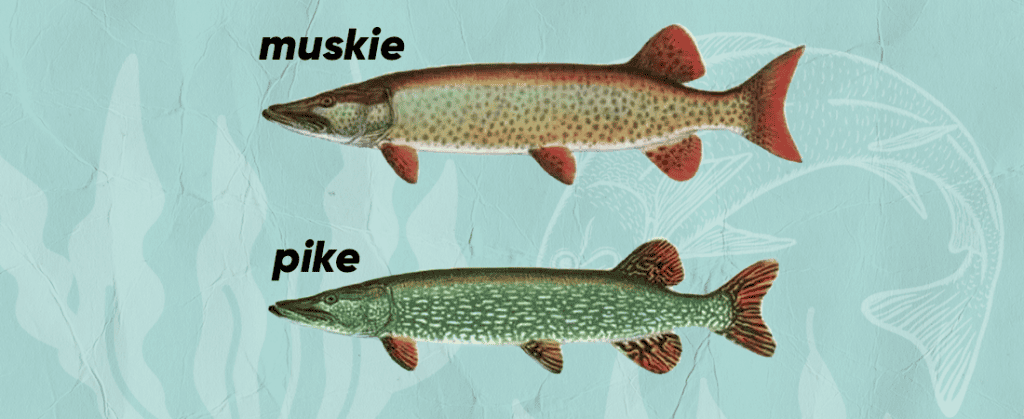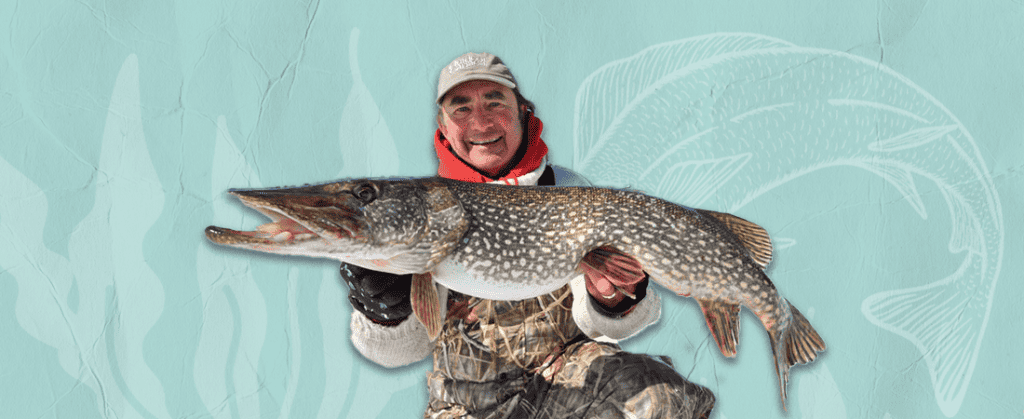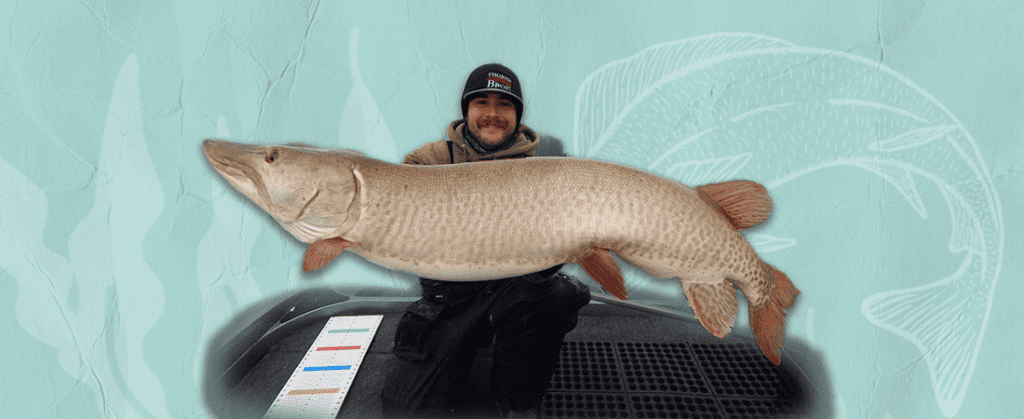
Have you ever caught what you thought was a muskie only to learn it was a pike or vice versa? You are not alone. Many anglers have thought they are the same fish. But are muskie and pike the same? And what is the difference between a muskie and a pike?
Muskies, also called muskellunge, and pike look similar because they belong to the same family and genus. But they are distinct species and should be treated as such. This guide covers in detail the differences between muskellunge vs pike. We will also discuss how to catch these freshwater game fish.

Written by
Larry Stark, Founder / Main Editor
Professional fisherman, who loves to review new fishing gadgets.
Table of Contents
Muskie vs Pike: Size
Muskies are generally larger than pikes. According to world records, they can reach over 60 inches, with the largest muskie ever caught reaching 72 inches. Today, most muskies caught have an average length of 30 to 40 inches.
Northern pike are often half the size of muskie, with an average length of 17 to 25 inches. According to Guinness World Records, Louie Spray caught the largest pike at 63 inches long.
Muskie vs Pike: Weight
Regarding muskie vs northern pike weight, muskies have a higher average weight than their cousins. The average pike weight is 2 to 5 pounds, with muskellunge weighing between 10 and 20 pounds.
On occasion, anglers have caught extreme sizes of muskie and pike. The largest muskie on record weighed 67 pounds and measured 60 inches. This was back in 1949 when Cal Johnson caught this monster fish in Lake Court Oreilles.
Meanwhile, Peter Dubuc caught the largest pike in North America in 1940 on Lake Sacandaga, upstate New York. This big fish weighed 46 pounds. However, Germany holds the world’s biggest Northern pike record of a 55-pound fish.
Muskie vs Pike: Location
Northern pike is more distributed than muskie. As their name suggests, pike live in the Northern Hemisphere, from Europe to North America and Asia. Germany, Finland, Denmark, and Russia have the highest concentrations of pike in Europe.
Over 30 states have pike in the United States, including Alaska, Maine, Arizona, and New Mexico. You can go pike fishing in the Great Lakes region or the upper Mississippi River. Plans to stock Northern pike have seen the fish travel further south in states like Georgia and Texas.
Eastern Canada is also home to these game fish. They are native to Ontario, Quebec, Alberta, Lake Manitoba, and Saskatchewan.
The Baltic Sea also holds high pike populations, a unique phenomenon considering pike is a freshwater fish living in brackish water.
Muskies, however, are only distributed in North America and southern parts of Canada. Musky are native to Tennessee, Ontario, Minnesota, and New York. The Great Lakes have the highest musky populations. Still, you can also find them in the St. Lawrence River, the Broad River, the upper Mississippi River basin, and the Tennessee River valley.
Interestingly, pike and muskies can co-exist in the same location, with Eagle Lake, Lake Wabigoon, Leech Lake, and St. Lawrence River being some of their shared habitats. On rare occasions, these cousins have an overlapping spawning season, creating a hybrid fish called tiger musky.
Tiger muskies come to be when male northern pike fertilize the eggs of a female muskellunge. These crossbreeds are rare in the wild, but fish and game organizations purposely crossbreed the parents in hatcheries and stock them in rivers and lakes.
Muskie vs Pike: Habitat

Regarding pike and muskie habitat, both fish prefer clear water. Experts believe that this is because they rely on sight to hunt.
They hide in shallow water with weeds, thick vegetation, submerged trees, flats, or rocks, waiting for prey to swim their way. Once they catch prey, they suspend on the surface or move to the oxygenated bottom to rest.
Muskies are picky about their habitat and prefer large rivers and medium-to-large lakes. They love cooler water, unlike their cousins, who can tolerate cold water, they love cooler water. You’ll find pike in small rivers and streams.
Both muskies and pike thrive in shallow, sluggish water. But on occasion, when the shallows become warmer, they’ll move up to 40 feet down. Or, if the baitfish move to deeper columns, these predators will follow the food. But musky will prefer to sit in shallow vegetation that grants them fast access to deeper water.
What do muskie and pike eat? Muskellunge primarily feeds on fish, making up 95% of its diet. They also feed on frogs, ducks, mice, muskrats, and anything that fits their mouth.
Do muskies eat pike? Yes. On occasion, a hungry muskie will eat pike. Besides, muskies are territorial, meaning any wandering pike will likely become food. However, the pike is not part of a musky’s essential diet, but these aggressive predators will not let an opportunity pass them.
On the other hand, about 90% of pike’s diet is small fish. Other living creatures like rodents, frogs, waterfowl, crayfish, and snakes supplement their diet.
Both these apex predators have a few natural predators. They strike fast, grabbing prey by the head before locking them in with their jaws. And they feature lots of razor-sharp teeth to tear into flesh.
Tiger muskies also prefer clear water and hide between rocks, weeds, vegetation, and other structures to ambush prey, just like their parents. They also love water bodies with shallow and deep areas for hiding and foraging.
Tiger muskies are carnivorous and mostly eat fish. They are also opportunistic predators who’ll devour small birds, mammals, and animals that look like food.
Muskie vs Pike: Colors & Marks (Patterning)

Regarding muskie and pike identification, muskie have a different body coloration to pike. Here is an easy breakdown: Pike have lighter spots on a dark background, while musky spots are darker on a lighter background.
So, what does a muskie look like? It depends on the strain. The two common musky strains are the Wisconsin River strain (Chippewa) and the Great Lakes strain.
The Wisconsin River strain is distinct for its prominent dark, vertical bars on the sides of the body, but some have clear sides with faint markings. The fish also feature a green and gold coloration and is highly stocked throughout the country. Muskie greenish-orange color helps them camouflage in thick vegetation and underwater weeds while waiting for prey.
With the Great Lakes strain, these muskies have dot markings with light silver coloration. This differs from the bars on the Chippewa strain and the green and gold coloration. You’ll find high musky populations in Tennessee, Kentucky, and Minnesota.
Meanwhile, Northern Pike has olive green, dark green, or dim green-blue body coloration with white or cream-colored, bean-shaped spots running along the body. When both fish are in the water, pike have very dark color backs compared to the more brownish-gold coloration on muskies.
Let’s also discuss a tiger muskie’s body color and patterns, as you may come across one when fishing. Unlike its parents, the tiger muskie does not have one definitive look. It takes 50% DNA from each parent, meaning they have both spots and bars.
The common tiger muskie have a light background with vertical black markings and stripes merging on the back to create an interlocking pattern. Some hybrids also have alternating patterns of stripes and spots like a tiger.
Muskie vs Pike: Pores
If color and patterns don’t cut it, you can differentiate muskies from pike from their jaw pores that resemble small holes. These sensory pores work as a lateral line to detect vibrations and movement in the water. These fish use them to approximate their prey’s distance so they can strike.
The pores are located on the underside of the jaw, so you have to flip the fish over to see them. Checking the pores is dangerous, so ensure you handle the fish gently while supporting the midsection. Or, lay it on an unhooking mat and pour water over its head to keep it oxygenated and calm. Do not at any point put your fingers close to the fish’s mouth to avoid nasty bites as they try to break free.
Now back to counting the sensory pores, pikes have 4 to 5 pores on each side of the lower jaw, whereas muskies have 6 to 9 pores.
Muskie vs Pike: Gill Cover
The gill cover is also different in the two fish. Pike have scales all over the cheek, while muskies only have scales on their upper half.
And you can count the branchiostegal rays found on the gill plate, which is a delicate and difficult task. But you’ll find 13 to 16 branchiostegal rays in Northern pike and 16 to 19 in muskies.
Muskie vs Pike: Tail Shape
Avid musky anglers use the tail shape as one of the instant distinguishing features between muskie and pike. Although the two fish feature forked tails, the Northern pike have rounded tails compared to the pointed tip in muskie that creates a prominent V-shape.
Muskie vs Pike: Fins
You can also tell the difference between pike and muskie from their caudal fins. Pike has a stripped caudal fin, while musky has a plain or spotted fin.
Also, pike tails have orange and yellow coloration at the base with black bars. Muskies have red or reddish-brown fins with no markings or very small dotted markings.
How to Catch Pike and Muskie?
Now, you know what pike and muskies look like, their average size and weight, and their habitat. But how do you catch these prized fish? Let’s start with pike fishing tips.
Northern pike also called the water wolves, are aggressive and strike almost everything. From brightly-colored lures to shiny and noisy lures, these fish will go for a bite. Some of the best pike lures for Northern pike include spinnerbaits, large spoons, and shallow-running lures. And you can use live bait such as frogs, shad, minnows, and suckers.
You should always consider the size of the lures depending on the time of the year. Pike are attracted to larger bait in fall to stock up winter supplies, then opt for smaller bait in winter. Also, use erratic speeds and momentary pauses to attract the fish in the warmer months.
Remember that the Northern pike is powerful and will put up an intense fight. So use a baitcasting reel with a braided line. Also, use weedless flies and a steel leader to avoid losing the line and the fish.
Your muskie fishing experience will be different from pike. Muskies are picky and will even chase lures several times to the boat before swimming away. It is no wonder muskies are called ‘the fish of ten thousand casts’. Other times, muskies will take the bite and then display acrobatics to throw the hook.
But that’s not to mean you cannot catch one, as we have a few muskie fishing tips up our sleeves.
The best musky lures are large bucktail spinners, large jigs, diving plugs, jerkbaits, or any aggressive bait that will trill the predatory instinct. With their sheer strength, you need the best musky rod and the best musky reel to work with heavy lures.
Exercise patience if you want to catch muskies. This species is notorious for following the bait until the last minute. Always use varying speeds when retrieving and finish with a large figure 8 to confirm if a musky is following. Like pike, always use a steel leader, and choose smaller bait during cold winter weather and larger bait in fall.
Frequently Asked Questions About The Difference Between Muskie and Pike
Muskellunge and pike belong to the same family group Esocidae and the same genus, Esox. Other very similar fish in this family include amur pike, southern pike, chain pickerel, and American pickerel.
Yes. Muskie and pike can co-exist in the same waters. In fact, you can find them in the Great Lakes and the St. Lawrence River. However, the water body must be large and have plenty of prey for the two fish to live together.
Adult muskies are apex predators, with humans as their major threat. These fish have speed, strength, tuned instincts, and sharp teeth to tear their prey. And they have evolved to become one of nature’s greatest freshwater hunters. Juveniles, however, are prey to other muskies, trout, and pike.
Adult pike have few natural predators, too, making them apex predators. But, they face the threat of humans and sea lampreys, and their juveniles make easy meals for some birds of prey, otters, and larger fish.
Yes. Pike and muskie are carnivorous and feed on frogs, crayfish, smaller fish, birds, and mammals. These ambush hunters hide in shallow bays, weed beds, and drop-offs, swiftly striking anything that fits in their mouth.
